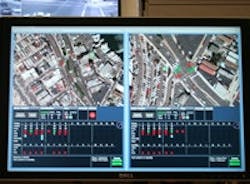TM&E Application Story - Newport Beach, Calif., Advances Traffic Management Capabilities
City connects with new system to proactively re-time traffic signals
The city of Newport Beach, Calif., recently deployed a new centralized advanced transportation management system (ATMS) as part of a 2007 Traffic Signal Modernization project. The project, replacing an older system installed in the 1980s, will upgrade nearly 120 traffic signals to improve system reliability, streamline operations and help enhance mobility.
Newport Beach, situated along the California coast in Orange County, occupies an area of 53 square miles, but only 23.8 of those are land, limiting expansion of roadway capacity. Newport Beach considers itself a community of villages with a population of 85,186. The city’s quaintness belies its seasonal traffic density. Instead of weekday commute issues, Newport Beach deals with weekend and Summer tourist traffic crushes, which can see its population triple in a couple of hours, with traffic counts exceeding 100,000 vehicles along all corridors leading to the beach areas. In addition, maintaining the 25-year-old traffic system that was no longer supported placed a significant burden on the city’s four-person Traffic Engineering Division. The lack of system reliability required at least one traffic engineer to service non-operating intersections on a seven-day-a-week basis. Moreover, signal-timing changes were reactive and required a traffic engineer to physically make changes at each intersection while communicating with another engineer at City Hall.
By 2005, the reliability of the system degraded to the point that Transportation Services personnel had to spend time searching and bidding for components on Internet auction sites in an attempt at keeping the system operating. Despite these gallant efforts, signals failed regularly, creating traffic “friction” and “distraction” that often paralyzed mobility.
In 2010, system deployment began, which included installation of Econolite Centracs ATMS and ASC/3 controllers, as well as an independent, standalone CCTV system. The project is being completed in multiple phases:
- ?Coast Highway and MacArthur Boulevard Corridors—22 intersections retimed and installation of two CCTV cameras (phase complete);
- Jamboree Road Corridor and the Airport Area—29 intersections and installation of 13 CCTV cameras (phase complete);
- West Newport and the Balboa Peninsula area—30 intersections and installation of seven CCTV cameras (phase complete); and
- Newport Center area, the Newport Coast Drive and San Joaquin Hills Road corridors, and East Newport is anticipated to be funded and implemented by 2012.
Having increased mobility, the project established a reliable system that is easy to maintain, reduces staff workload, and provides real-time traffic management capabilities. Due to the ATMS design, intersection integration requires minutes rather than hours. As a result, more than half of the city’s intersections have already been brought online with the new ATMS.
In addition, the entire system is controlled at the Traffic Management Center (TMC) located at City Hall. Equipped with a series of computers and display monitors, the TMC monitors intersections from the closed-circuit cameras, enabling traffic engineers to remotely track signal operations, traffic flows and, as a result, adjust signal coordination and timing in real time via the ATMS.
The new system also enables engineers to proactively re-time signals and monitor for roadway construction, traffic incidents, special events, emergency situations, and even weather.
